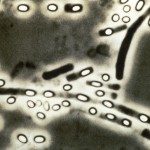Link to Pubmed [PMID] – 20144678
Biochimie 2010 Jun;92(6):583-7
Type-IIA secreted phospholipase A(2) (sPLA(2)-IIA) has been proposed to play a role in the development of inflammatory diseases. It has been shown to release arachidonic acid, the precursor of proinflammatory eicosanoids, to hydrolyze phospholipids of pulmonary surfactant, and to bind to specific receptors located on cell surface membranes. However, the most established biological role of sPLA(2)-IIA is related to its potent bactericidal property in particular toward Gram-positive bacteria. This enzyme is present in animal and human biological fluids at concentrations sufficient to kill bacteria. Human recombinant sPLA(2)-IIA is able to kill Gram-positive bacteria at concentrations as low as 1.1 ng/ml. This remarkable property is due to the unique preference of sPLA(2)-IIA for anionic phospholipids such as phosphatidylglycerol, the main phospholipid component of bacterial membranes. Much higher concentrations of sPLA(2)-IIA are required for its action on host cell membranes and surfactant both of which are mainly composed by phosphatidylcholine, a poor substrate for sPLA(2)-IIA. Transgenic mice over-expressing human sPLA(2)-IIA are resistant to infection by Staphylococcus aureus, Escherichia coli, and Bacillus anthracis, the etiological agent of anthrax. Conversely, certain bacteria, such as B. anthracis, E. coli and Bordetella pertussis are able to inhibit sPLA(2)-IIA expression by host cells, thus highlighting a mechanism by which these bacteria can subvert the host immune system. Intranasal instillation of recombinant sPLA(2)-IIA protects mice from mortality caused by pulmonary anthrax. Interestingly, this protective effect was obtained even with B. anthracis strains that down-regulate the expression of endogenous sPLA(2)-IIA, indicating that instilled sPLA(2)-IIA can overcome the subversive action of B. anthracis. We conclude that sPLA(2)-IIA is an efficient endogenous antibiotic of the host and can play a role in host defense against pathogenic bacteria. It can be used as a therapeutic agent in adjunct with current therapy to treat bacteria resistant to multiple antibiotics.



